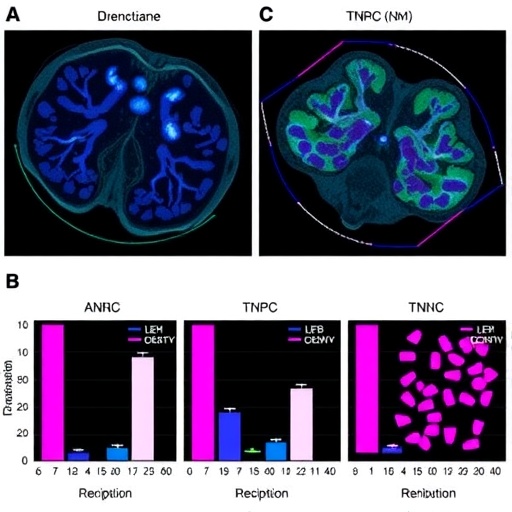PROTECT YOUR DNA WITH QUANTUM TECHNOLOGY
Orgo-Life the new way to the future Advertising by AdpathwayIn a groundbreaking study published in Scientific Reports, a team of researchers led by Simović, Drljača, and Kovačević has unveiled a novel exploration into the field of optical fibers. Their research focuses on doubly clad microstructured graded-index polymer optical fibers (GI POF), revealing a significant enhancement in bandwidth performance that varies with wavelength. This advancement not only promises to refine the efficiency of optical communication systems but also marks a pivotal shift towards the utilization of polymer-based optical fibers that could transform various industries reliant on high-speed data transmission.
The findings demonstrate that the inner composition of these fibers plays a crucial role in determining their operational bandwidth capabilities. Specifically, the researchers investigated the realistic implications of microstructure and material choices on the light propagation characteristics through these fibers. Utilizing innovative methodologies, they varied the geometries and configurations of the fiber cladding and core, leading to intriguing results that highlight the customizability of optical performance in this promising class of materials.
At the core of their work lies a detailed analysis of scatter losses and refractive index profiles which are integral to the functioning of graded-index optical fibers. This study sheds light on the intricate balance required between fiber design and material properties to minimize signal degradation over increasing distances—a major concern in modern telecommunication systems. The researchers discovered that by carefully optimizing the cladding parameters, they could achieve substantial reductions in loss rates, translating into improved signal clarity and data rates.
The implications of these findings extend beyond pure academic interest; they hold significant potential for real-world applications, especially in areas where bandwidth limitations pose challenges to transmission quality. High-speed internet access, for instance, would greatly benefit from the deployment of these advanced GI POFs, facilitating faster uploads and downloads while enhancing streaming services. This research positions the researchers at the forefront of optical communications technology, paving the way for new standards in fiber optic performance.
Moreover, the environmental footprint associated with polymer optical fibers is significantly lower compared to traditional glass fibers. This presents a dual benefit: not only can data transmission be made more efficient, but the ecological impact can be mitigated. Such sustainable solutions are paramount as industries increasingly prioritize green technologies. The findings from this study equip engineers and manufacturers with essential knowledge needed to advance sustainable practices without sacrificing performance.
Another fascinating aspect of the research involves the exploration of temperature sensitivity in these fibers. The team delved into how changes in ambient temperature affect the optical properties, which is critical for applications in harsh environments. Understanding how temperature variations influence the performance can lead to the development of more robust fibers suitable for various climatic conditions, further solidifying the versatility of polymer optical materials in communications.
As the digital landscape continues to evolve, the demand for higher bandwidth capabilities shows no signs of slowing. Traditional optical fibers, while effective, face increasing challenges due to their rigidity and complexity when installed. The flexibility and adaptability of microstructured polymer fibers offer a compelling alternative. The study’s insights into increasing the operational flexibility of these fibers could lead to new deployment strategies, particularly in urban environments where traditional installations are often fraught with logistical difficulties.
Furthermore, the team utilized advanced simulation techniques to model their experiments accurately. These modeling approaches allowed for comprehensive insights into optical performance and facilitated rapid iterations of design changes, a vital requirement in the fast-paced engineering landscape. Such methodologies underscore the importance of computational tools in modern physics and engineering, driving innovation faster than ever.
In the wake of this breakthrough, collaboration across disciplines will be crucial. As the researchers aim to transition their findings from laboratory experiments to practical applications, partnerships with telecommunications companies and material suppliers will provide invaluable insights into market needs and help validate these innovations in real-world environments.
Their work not only bolsters our understanding of how microstructured fiber designs can be optimized but also aligns with the global movement towards the deployment of better, faster, and more sustainable technologies. As the researchers continue to hone their focus on the microstructural aspects of polymer fibers, the potential for further innovations seems promising. New avenues for exploration could yield even higher bandwidths and lower losses.
In conclusion, the research team led by Simović, Drljača, and Kovačević has taken significant steps in unlocking the potential of microstructured GI POF. Their findings herald a new era in optical fiber technology, where speed, efficiency, and sustainability converge. As we stand on the precipice of a more connected future, studies such as this one are vital in driving forward the technologies that will support our increasingly digital lifestyles.
Subject of Research: Microstructured graded-index polymer optical fibers (GI POF)
Article Title: High wavelength dependent bandwidth performance of doubly clad microstructured GI POF
Article References:
Simović, A., Drljača, B., Kovačević, M.S. et al. High wavelength dependent bandwidth performance of doubly clad microstructured GI POF. Sci Rep 15, 40656 (2025). https://doi.org/10.1038/s41598-025-25474-7
Image Credits: AI Generated
DOI: https://doi.org/10.1038/s41598-025-25474-7
Keywords: Optical fibers, polymer, telecommunications, bandwidth, microstructure, sustainability.
Tags: bandwidth enhancement with wavelength variationcustomizability of optical performance in fibersdoubly clad microstructured graded-index polymer optical fibersgeometries and configurations of optical fiber claddinghigh-speed data transmission technologiesinnovative methodologies in optical fiber researchlight propagation characteristics in optical fibersmicrostructure and material choices in fiber opticsoptical communication systems efficiencypolymer-based optical fibers advancementsrefractive index profiles in optical fibersscatter losses in graded-index optical fibers


 5 hours ago
4
5 hours ago
4





















 English (US) ·
English (US) ·  French (CA) ·
French (CA) ·